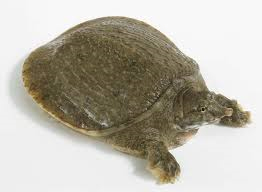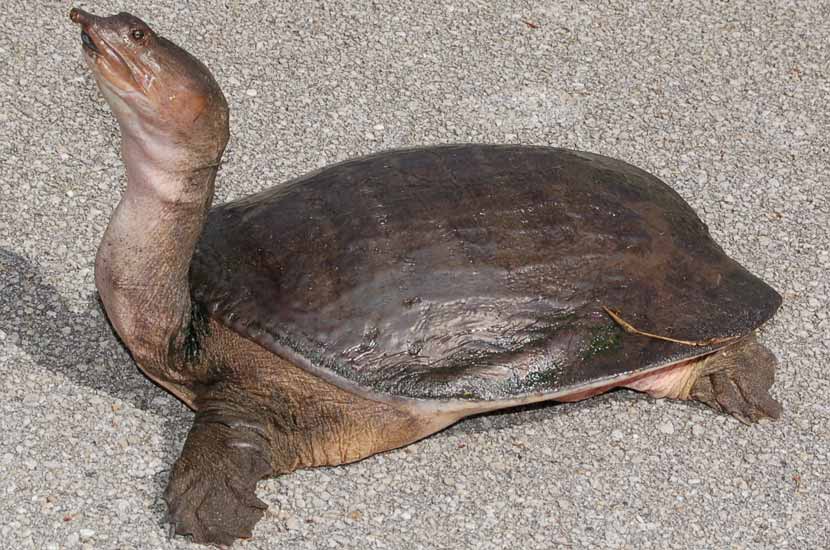Erica Mede, CVT
Natural History
 Throughout central and south eastern United States , the soft sandy and muddy bottoms of rivers, lakes and ponds are home to the unique soft shell turtle. These beautiful animals make unique display pets that will entertain folks for 30-40 years! The Florida soft shell (Apalone ferox), Smooth soft shell (Apalone mutica), and the Spiny soft shell (Apalone spinifera) are the most commonly kept soft shells in captivity.
Throughout central and south eastern United States , the soft sandy and muddy bottoms of rivers, lakes and ponds are home to the unique soft shell turtle. These beautiful animals make unique display pets that will entertain folks for 30-40 years! The Florida soft shell (Apalone ferox), Smooth soft shell (Apalone mutica), and the Spiny soft shell (Apalone spinifera) are the most commonly kept soft shells in captivity.
These turtles are exceptionally agile swimmers with lightening fast response time. The Spiny and Smooth are up to 14 inches long and the Florida soft shell is a massive 24 inches long just in the carapace length. The males are significantly smaller than the females. The unique skin covered flattened carapace is devoid of scutes but there are firm carapacial bones over the spine and ribs just as there is in other turtles. Their long snorkel like nose combined with their long necks allow them to remain submerged on the bottom of the river floor while still being able to breath. The nostrils will poke through the surface of the water just like a periscope.
A word of caution with handling! These animals have delicate skin which can be abraded easily. Treat them gently and only handle them when necessary. Also, their impressive claws on their feet and ability to stretch their necks half way down their carapace are excellent reasons to avoid handling. The “fleshy” looking lips hide a very sharp cutting edge of their beak that can cause injuries deep enough for stitches.
In 1975, the United States government banned the sale of any chelonian with a carapace (top shell) less than four inches long in hopes of preventing the spread of Salmonella and the destruction of native species in the wild. With the age of easily accessible information via the World Wide Web, private breeders have been successfully breeding and incubating Map turtles and now offer their domestically bred chelonians online. As to the legalities regarding this practice, that is for the government to decide. Domestically bred Map turtles are always recommended over their wild caught counterparts.
Quarantine
It is recommended that all new turtles be quarantined away from the rest of the household chelonians for at least 60-90 days. In this time period the owner can access the animals’ behavior and health status. Chicago Exotics strongly urges owners to bring these animals in during quarantine for a wellness exam and a fecal evaluation. Quarantine requires food, dishes, accessories, and cleaning of the chelonian to be done separately (typically after) from the other chelonians.
Enclosure
The larger the enclosure for juveniles and adults the better! This species loves to swim and bury themselves on the bottom of their enclosures. Many even enjoy items such as ping pong balls floating on the water surface as a toy! These turtles need to be placed in a low traffic area. It is strongly encouraged to house these animals alone or in a breeding pair but caution should be used.
Young turtles can be kept in 20 gallon long aquariums but will quickly need to be relocated to a 40 gallon breeder aquarium when they reach the juvenile and sub adult stage. Most adults (especially females) will require a 50-100 gallon aquarium or equivalent enclosure. Some owners opt to create custom enclosures for their pets as well. Generally speaking, there should be 6 inches of aquarium floor per every 1 inch of turtle. If the turtle has a carapace length of 9 inches, it will require 54 inches of aquarium floor space. Other enclosures to consider for multiple turtles include modified plastic tubs, outdoor ponds, and Koi tubs. With a bit of creativity, enclosure potential is endless!
Substrate and Water Quality
 With soft shell turtles, it is recommended to have a layer of thick, fine quality sand as substrate in the tank. This sand must be fine and of high quality to prevent the turtle’s delicate skin from being damaged. Canister filters are recommended by Chicago Exotics for all chelonians as they offer mechanical and biofiltration. Canister filters are generally less stressful to aquatics as there is no mechanical vibration on the tank from the filter body itself. Fluval, Magnum, and Eheim make excellent filters and there are a few websites that illustrate how to create your own canister filter. External filtration helps to remove uneaten food and large waste particles as well as agitate surfaces and increase water oxygenation. An under gravel filter is not enough filtration to maintain a clean environment and will need to be supplemented with other filtration devices. Every 2-4 weeks the sand should be removed from the tank and replaced. All cage furnishings should be removed and scrubbed well with a toothbrush designated for the job and bleach diluted 1:20 with water every 2-4 weeks as well.
With soft shell turtles, it is recommended to have a layer of thick, fine quality sand as substrate in the tank. This sand must be fine and of high quality to prevent the turtle’s delicate skin from being damaged. Canister filters are recommended by Chicago Exotics for all chelonians as they offer mechanical and biofiltration. Canister filters are generally less stressful to aquatics as there is no mechanical vibration on the tank from the filter body itself. Fluval, Magnum, and Eheim make excellent filters and there are a few websites that illustrate how to create your own canister filter. External filtration helps to remove uneaten food and large waste particles as well as agitate surfaces and increase water oxygenation. An under gravel filter is not enough filtration to maintain a clean environment and will need to be supplemented with other filtration devices. Every 2-4 weeks the sand should be removed from the tank and replaced. All cage furnishings should be removed and scrubbed well with a toothbrush designated for the job and bleach diluted 1:20 with water every 2-4 weeks as well.
The water for these turtles is critically important! These are fresh water turtles who enjoy remaining submerged so the chlorine free water depth should be just to the level of the proboscis (the nose) when buried under the sand. Change a third of the water once a week to keep the water clean. It is critical to maintain the pH balance between 6.6 – 7.6 and a slightly brackish salinity.
Temperatures
Typically, the water temperature should be maintained between 74°F and 84°F depending on if it is a Southern species (towards the warm end) or a Northern species (towards the cool end). A thermometer in the water is highly recommended at the location furthest away from any heat source and one near the heat source. Water temperature can be maintained using a submersible water heater or under tank heater on a thermostat. If a submersible water heater is used, it is recommended to place a piece of PVC pipe with several holes drilled into the sides of it over the heater to prevent accidental burns and biting. A general rule of thumb is a 75 watt heater will work for a 40 gallon tank, a 55 watt heater for a 55 gallon tank, and a 200 watt heater for a 100 gallon aquarium.
The basking light should be over a flat stone such as slate or log. Basking sites should be between 85 and 90 degrees Fahrenheit and easily accessible to the chelonian. Metal clamp lamps work well for these sites. The ambient temperature of the tank can be increased with under tank heaters and/or the basking lamp as well and maintained at 74-80°F. During the night, under tank heaters or ceramic heat emitters can be used to increase the ambient temperature as it will offer no light.
Light Cycle
As with most reptiles, soft shell turtles do well on a light cycle that simulates 12 hours of daylight and 12 hours of darkness. A high quality UVB bulb such as a 5.0 ReptiSun bulb is recommended for adults and a 10.0 ReptiSun bulb is recommended for hatchlings and young turtles. These bulbs help the body convert vitamin D3 into calcium and helps prevent the disfiguring and deadly metabolic bone disease which is generally caused by a lack of available calcium in the reptiles’ body causing the body to absorb calcium from the bones.
Feeding
Hatchlings and juveniles are highly carnivorous (preferring meat) and become omnivorous (eating both vegetation and meat) as adults. The key to a healthy turtle is variety in their diet! Aquatic plants such as algae and duck weed are relished by these chelonians but most owners offer romaine lettuce, cantaloupe, banana, kale, mango, and strawberries as treats. Water hyacinth, water lettuce and water cress can easily be cultivated at home with some diligence and offer enrichment and nutrition. Small to medium sized fish (not goldfish), insects (crickets, earthworms, red worms), and snails are offered for the meat portion of their diet. Supplementation with commercially produced turtle pellets is recommended as well. Some people prefer to feed only commercially produced turtle pellets, in this case, Chicago Exotics recommends feeding multiple brands of turtle pellets or Mazuri Freshwater turtle diet.
In the wild, these chelonians embark on daily foraging expeditions throughout their habitat even stealing food from the mouth of other turtles! In captivity, feeding varies with age and the energy output of the turtle. Hatchlings are fed two times a day as much as they will eat in 10-15 minutes. Adults are fed once a day and as much as they can consume in 10-15 minutes. It is recommended to come up with a standard food amount for adult chelonians to be fed daily to monitor appetite changes. If the water is becoming fouled too quickly or the turtle is becoming obese then the food will need to be decreased. All food should be sprinkled with a multi-vitamin once a week and a calcium supplement daily for hatchlings and three times a week for adults.
Sources and Recommended Readings
Turtles of the World, Carl H. Ernst and Roger W. Barbour
Turtles of the United States and Canada, Carl H. Ernst, Jeffery E. Lovich, Roger W. Barbour
Keeping and Breeding Freshwater Turtles, Russ Gurley
The General Care and Maintenance of Red Eared Sliders and Other Popular Freshwater Turtles, P. de Vosjoli
Aquatic Turtles, David T. Kirkpatrick
Turtles and Tortoises, R. D. Bartlett
Tortoise Trust, www.tortoisetrust.org
If you have any questions, please feel free to call us at (502) 241-4117.

